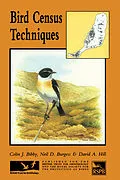Wild birds are counted for a wide variety of reasons and by a bewildering array of methods. However, detailed descriptions of the techniques used and the rationale adopted are scattered in the literature, and the newcomer to bird census work or the experienced bird counter in search of a wider view, may well have difficulty in coming to grips with the subject as a whole. While not an end in itself, numerical and distributional census work is a fundamental part of many scientific and conservation studies, and one in which the application of given standards is vital if results are not to be distorted or applied in a misleading way.
This book provides a concise guide to the various census techniques and to the opportunities and pitfalls which each entails. The common methods are described in detail, and illustrated through an abundance of diagrams showing examples of actual and theoretical census studies. Anyone with a bird census job to plan should be able to select the method best suited to the study at hand, and to apply it to best effect within the limits inherent in it and the constraints of the particular study.
The Royal Society for the Protection of Birds and the British Trust for Ornithology have for many years pioneered the collaboration of amateurs and professionals in various census studies. Three members of their staff, each with extensive field experience, now pool the knowledge of these investigations to lay the groundwork for sound census work in future years.
Autorentext
Colin Bibby is Director of Science and Policy at the International Council for Bird Preservation where he is interested in the role of birds as indicators for global biodiversity conservation. While Head of Conservation Science at the Royal Society for the Protection of birds, he was a co-author of Red Data Birds in Britain. In both capacities, he has been struck by the small number of birds of conservation concern which have been counted adequately. He has counted birds in Britain and Europe, as a professional, as an amateur participant, and as an organizer of surveys for the British Trust for Ornithology. He was motivated to start this book by the belief that bird-watchers would contribute more to conservation if they put more effort into counting birds, but lack of guidance on methods was a handicap.
Inhalt
Purpose and Design in Counting Birds. Census Errors. Territory Mapping Methods Line Transects. Point Contacts. Catching and Marking. Counting Individual Species. Counting Colonial Flocking and Nesting Birds. Distribution Studies. Description and Measurement of Bird Habitat Chapter Summaries and Points to Consider. Index.
